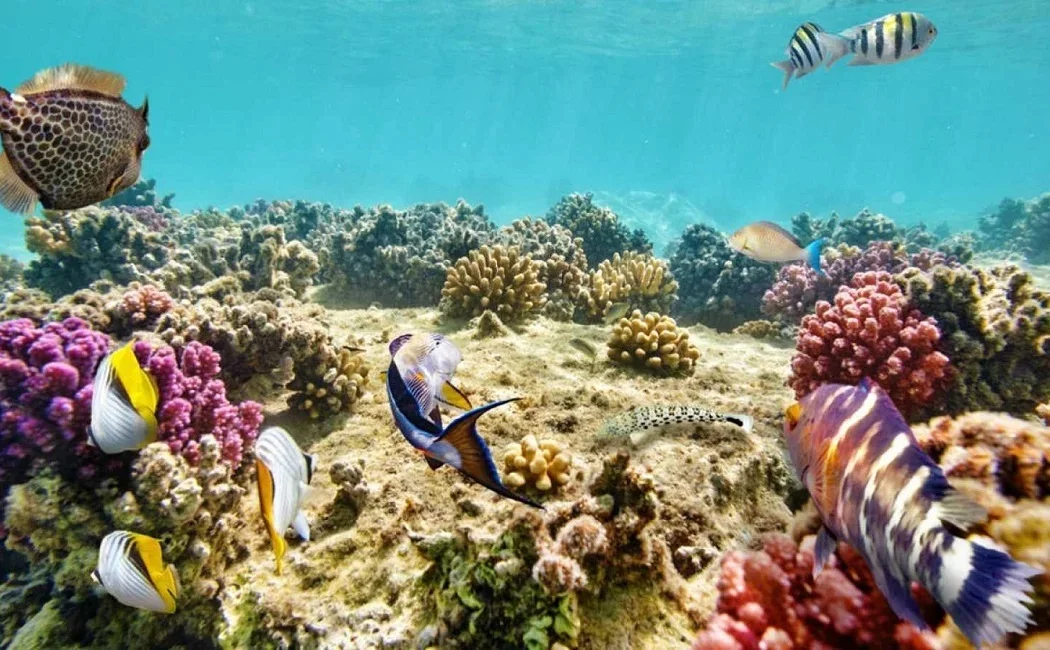Australia's Great Barrier Reef is the largest coral reef in the world. The reef is situated in the Coral Sea, off the coast of Queensland to the northeast of Australia, southeast of Western New Guinea and south of Papua New Guinea. The reef, which stretches over some 2,600 kilometers in length, can be seen from space.
 |
| Great Barrier Reef |
The first European explorer to spot the Great Barrier Reef was Captain James Cook on his voyage in 1768. Cook discovered the reef when he ran aground on it on June 11, 1770. Due to its vast biological diversity, its clear temperate waters and Due to its easy accessibility, the reef is a very popular destination among scuba divers. Many cities on the Queensland coast (such as Cairns and Townsville) offer daily boat trips to the reef. The Great Barrier Reef is sometimes referred to as the largest living animal in the world.
Actually, it consists of the ancient accumulation of many skeletons of coral colonies of the order Scleractinia, composed of calcium carbonate, mainly aragonite. On these structures, which extend for kilometers, one of the largest concentrations of biodiversity on the planet is agglutinated. A large area of the reef is protected by the Great Barrier Reef Marine Park.
 |
| Great Barrier Reef |
The Great Barrier Reef has been declared a World Heritage Site by UNESCO in 1981. It has an area of 34,870,000 ha. The Great Barrier Reef is one of the seven wonders of the natural world, and moving away from it, and seeing it from a greater distance, you can understand why. It is larger than the Great Wall of China and the only living thing on earth visible from space.
The Great Barrier Reef is a habitat for a large number of species, it is possible to find a large number of fish estimated at 1,800 different species, 125 sharks and more than 5,000 species of molluscs. In addition to about 400 species of coral. Species in danger of extinction, it is also possible to find in the barrier, species such as dugong and the great green turtle.
A close encounter with the Great Barrier Reef's stunning underwater gardens reveals many amazing sights such as the world's largest collection of corals (in fact, over 400 different types of coral), coral sponges, molluscs, rays, dolphins, more than 1500 species of tropical fish, more than 200 types of birds, about 20 types of reptiles, including sea turtles and giant clams over 120 years old.
 |
| Great Barrier Reef |
The Great Barrier Reef has been affected by global warming that affects the planet earth and is increasing more and more. Corals are very sensitive species to changes in ocean temperature. On the other hand, the effects of indiscriminate fishing and pollution have caused the barrier to be damaged, diminishing the ecosystem that is housed in it. If these actions continue, the Great Barrier Reef will continue to lose fish and aquatic flora. The "crown of thorns" starfish, which are deteriorating corals around the world, have also begun to affect the Great Barrier Reef, since the starfish, when they have reached their adulthood, consume what they measure, that is That is, if a starfish has a diameter of 60 cm, it consumes the same amount of hard coral daily.
Thirty species of whales, dolphins and porpoises have been recorded in the Great Barrier Reef, including the dwarf minke whale, the Indo-Pacific dolphin and the humpback whale. Large populations of dugongs live there. Six species of sea turtles come to the reefs: green turtles, leatherback turtles, hawksbill turtles, loggerhead turtles, and olive ridley turtles. The green sea turtle on the Great Barrier Reef has two genetically distinct populations, one in the northern part of the reef and the other in the southern part.
 |
| Great Barrier Reef |
Fifteen species of seagrass in the beds attract dugongs and turtles, and provide habitat for fish. The most common genera of seagrasses are Halophila and Halodule. Saltwater crocodiles live in the mangrove swamps and on the shore near the reef. Forty-nine species of fish and nine species of seahorses have been recorded. At least seven species of frogs inhabit the islands. 215 bird species (including 22 bird species and 32 shorebird species) visit the reef or nest or roost on the islands, including the White-bellied Sea Eagle and Roseate Tern. The islands of the Great Barrier Reef also support 2,195 known plant species. Three of them are endemic.
The North Islands have 300 to 350 species of plants that tend to be woody, while the South Islands have 200, which tend to be herbaceous, with the Whitsunday region being the most diverse, supporting 1,141 species. The plants are spread by birds. Seventeen species of sea snake live on the Great Barrier Reef, in the warm waters up to 50 meters (164 feet) deep, and are more common in the south than in the northern section. None of those found on the Great Barrier Reef are endemic, nor are they under threat of extinction.
